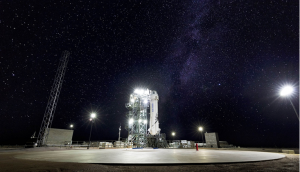

Blue Sky Analytics is a platform for creating environmental and climate data, and delivering it to customers through a common visualization dashboard in a spatial-temporal format and Application Programming Interfaces (APIs). The company provides final clean datasets from crude data that comes in the form of satellite data or imagery. Its ready environmental dataset may pertain to climate risk and carbon credits market.
Blue Sky Analytics aims to be ‘Bloomberg of environmental data’ for the world. It is planning global expansion and would soon be shifting to The Netherlands.
“We built all our software in house from the ground up. We take all data pertaining to the customer, their cause, all this intelligence, and we extract it, refine it, crunch it, and then we give it to you,” says Abhilasha Purwar, Founder & CEO, Blue Sky Analytics, in an exclusive interview with Geospatial World.
You can’t solve what you can’t measure. Let’s say there is a lake near your house and that lake is shrinking massively. As a normal person who just walks by without quantifying that data, what is the perception of the changing area of that lake, on a day-to-day basis?
Or in the same manner, there’s a lot of rainfall and the lake is overflowing. All of these things have to be measured on a consistent basis. Currently most of our systems are not capable of that. In fact, that’s why satellites were launched back in the 1970s.
One of the earliest missions of satellites were for Earth Observation — for seeing how the planet is changing. That’s how we got to a lot of our data around climate change. All the Intergovernmental Panel on Climate Change (IPCC) reports, where they talk about Arctic melting and everything, are obtained through satellite data. We make it much higher in resolution. We are not just monitoring what’s happening with Earth, but also at a very regional level; like what’s happening with lakes in Jaipur, Bangalore, and how they are expanding/contracting. We provide that hyper localized data, all the way up to 30-meter resolution.
All this is not new, but we build data products, we put it all on Cloud and we put artificial intelligence (AI) on top of it. For instance, if there’s a new satellite that’s launched by the Indian Space Research Organization (ISRO) or the Europe Space Agency, and it has new spectrum meters and higher resolution, all of that data will reflect in our datasets because they are dynamic. Static data leads to projects or research papers while dynamic data leads to data products.
Currently, we don’t understand completely where all our carbon emissions or PM2.5, CO2, NOs, or SO2 are coming from., or how much is coming. BlackRock has been talking a lot about climate action. They want to divest out of oil and gas and everything, but so much of their money is put still into coal and oil. We talk about quantifying, about saying that we have asset level information now. This asset level emissions data can help in decision-making.
Climate change is affecting the insurance industry a lot. The entire global economy is going to see a domino effect — like during the subprime mortgage crisis — from climate change. We must start to assess the physical risk from wildfires, floods, droughts, extreme heat, etc., in all of these places. In five to ten years, Blue Sky would almost emerge as a company that does not just provide data to financial institutions and banks, but to the public at large. That’s my vision for Blue Sky for this year and the next 10 years.
Larry Fink, who’s the CEO of BlackRock, has said that the next 1,000 unicorns will be climate tech unicorns.
When we talk about climate change in India, the narrative is around the binary of economic growth and sustainability. What I am proposing is that by being sustainable and solving climate change, we can grow our economy. India produces about 1.8 tons of carbon per capita. I think the figure for the US is around 15 tons, and something similar for most of Europe. We are in this situation because of Western growth that had been dependent on oil and gas. So even if one does look at a very comfortable life in India today, that life is still much less carbon-intensive than the average life in the US or in Europe.
This has come to be because of the way food systems are organized, because of the way clothing is organized. Much of clothing is essentially petrol: nylon, polyester, etc. Going to work from the suburb to a downtown area, revolves around oil.
On the other hand, the Indian way of life has been inherently low carbon. We should be much more ambitious and aggressive when it comes to climate change as a policy for the country. We should aim to lead the world rather than follow, because following the technologies and footprints of the last 50 years is exactly what has gotten us to this place. We should really go back to the roots, which is basic science and technology, basic lifestyle. With that, we can also lead the rest of the world. We can showcase what the different kinds of solutions are.
We also do a lot of predictive analysis of what would be the different scenarios in 1.5-degree warming and two-degree warming and so on. If we know how our agriculture will shift, how our forests will shift, how the habitability of our cities will shift 10 years from now, and you can start to move to places which are more resilient or you can start to do projects that are more resilient, something, I think it’s front and center of what we do at Blue Sky.
We provide high-resolution satellite intelligence for climate and environment so that banks, real estate, insurance, individuals, journalists, governments, etc can make decisions and plan. With our predictive analysis you’re not planning in dark. You’re not building your house on a floodplain. It is as simple as that.
Conventionally, we think of value creation as production. That’s the perspective with which a lot of manufacturing and industries come from and hence carbon emissions. What we believe at Blue Sky, is that value creation is optimization; using the resources in the most optimal manner. This is what telecommunication or the internet has done. Innovation or technology is fundamentally about optimization.
Using AI is another thing Blue Sky does. If one were doing it on a desktop by dragging a tile, running a code without using the Cloud and without using AI, it will take you a very long time. When you start using Cloud and AI, you can cover 400 lakes in six months. And then when you have to go from 400 lakes to 4,000, you can go in one week because it’s all using technology.
Cloud and AI are the main technologies that will impact the satellite and the analytics business in the coming years. There’s also a huge scope in telecom business with 5G and with satellite internet. What Starlink or OneWeb is doing can change the world. That can lead to so much deurbanization. The reason why most of us live in big cities is because some of the most fundamental needs like internet can be met in big cities.
If I can get 100 MBPS in a small village, I’m moving there. And if I move there, that’s carbon emissions saved. That’s so much cost saved. Blue Sky has been remote for two years now. We’ve decided to be remote forever. We heavy lift so much AI cloud APIs technology and we are spread across the country and everybody works remotely.


FOSS4G 2008 is the best opportunity this year for exposure and networking for your organisation. We are expecting 800-1000 managers and decision makers, users and developers from all over the geospatial world.
Raytheon Company has been competitively awarded one of the first Innovations in GeoSpatial Intelligence contracts by the National Geospatial-Intelligence Agency (NGA). The award is for development of the End-to-End Persistent Surveillance Demonstration an
© Geospatial Media and Communications. All Rights Reserved.